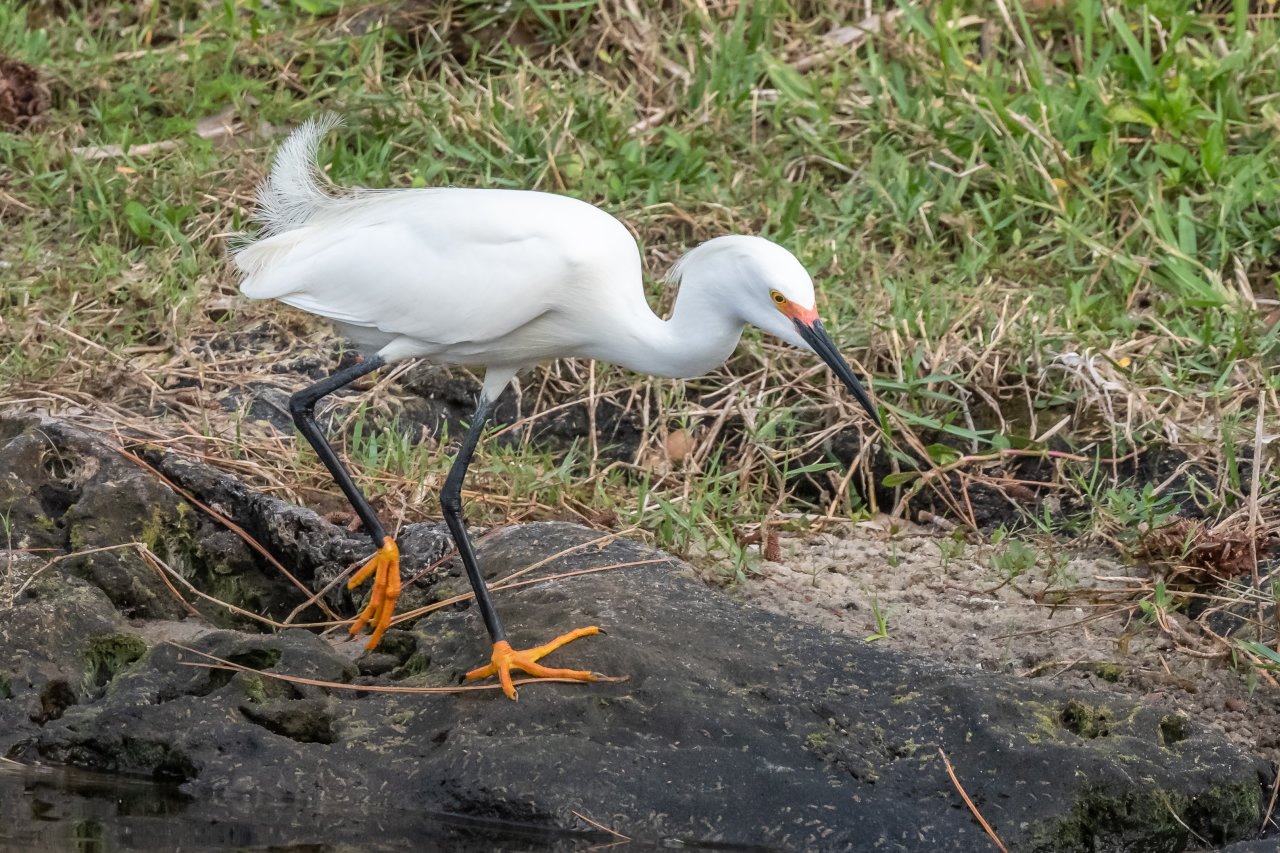While I am still in recovery mode from my recent hospitalization and pretty much confined to our Florida sunroom and patio, the birds are continuing to cooperate and provide sufficient material for yet a third column right here in our condo backyard.
The Snowy Egret (top) has not been around quite as much as it had been earlier, but it did make this dramatic appearance dressed in the start of its breeding plumage finery. Note how the “golden slippers,” normally a bright yellow, have taken on a bright orange color and the lores and base of the beak are now also that same bright orange. That bright orange in the face will continue to change, eventually turning into a bright red color. (Page 124 of the Hart Beat book shows a photo of this ultimate breeding plumage of the Snowy Egret.)
Another heron just coming into breeding plumage is the Tri-colored Heron. In its basic, or year-round, plumage (photo 2 taken on February 3rd of this year), the Tri-colored has yellow legs, a dark back and a plain yellow bill. By March 28th of this same year, on the far side of the pond (sometimes they just don’t cooperate and come close for excellent photo opportunities) the Tri-colored has moulted into its breeding plumage (photo 3) featuring bright red legs, gold feathering on the back, beautiful cream-colored plumes on the back of the head, and a bright blue bill.
Similarly, the Little Blue Heron in basic plumage (photo 4, taken February 11 of this year) has greenish legs, a plain light blue bill with a black tip and a purplish neck. By April 12th,, as it heads across our lawn for our shrubbery bushes and has moulted into breeding plumage (photo 5), the legs have become a much deeper and richer green, plumes have developed on the back and from the top of the head, the neck has turned a darker purple and, most significantly the bill has turned into a bright blue, but still with the black tip.
To summarize, these three backyard birding columns have featured the following egrets and herons, and some of their relatives, in addition to those presented in this column: White Ibis, Cattle Egret, Anhinga, Great Blue Heron, Limpkin, Double-crested Cormorant and Sandhill Crane. We certainly have never seen anything like that in our Pennsylvania backyard.
Two more species of ducks have shown up as well. The flock of Black-bellied Whistling Ducks (photo 6) shows up sporadically. We often see them flying over on their way to and from the Savannas County Park which is adjacent to our condo complex, and every now and then they stop over and give us a good view.
An unexpected visitor was this Muscovy Duck (photo 7) which is a feral introduced species often kept as a form of pet by some people. The Muscovy Duck in the wild is a Mexican coastal duck with a range that extends south as far as Peru and Argentina. In the United States it only appears occasionally in extreme south Texas along the Rio Grande River in the Brownsville area. Jewel and I spent several days searching for it years ago before we finally saw a couple and then only briefly. In the wild they do not have any of the red wart-like carbuncles although the male does have a knob at the base of a white bill and white in the wings. The domestic Muscovy Ducks we see here have varying amounts of white on various parts of the face and body. This individual has less than most although I do have photos from another St Lucie County location years ago with virtually no white on it at all.
These three backyard bird columns have now featured a Lesser Scaup, Mottled Duck, Black-bellied Whistling Ducks, and Muscovy Duck, as well as Egyptian Geese. Not one of these birds will ever show up in our Pennsylvania backyard.
There are also several hawks that show up regularly in our Florida backyard. The Osprey (photo 8) shows up regularly at our lake and often is quite successful at catching its daily meal. In March, the Swallow-tailed Kites (photo 9) begin showing up and fly over our backyard and the general area, not fishing, but searching the trees in around the condo units for bugs and insects. While Osprey fish our Pennsylvania farm pond they never appear in our backyard there. And, of course, Swallow-tailed Kites only range as far north as coastal South Carolina. I also have a photo of a Red-shouldered Hawk perched on top of the light pole behind our condo unit that I have not used in this series of columns.
I also considered using photos of two more critters, a gecko and an anole with its red throat flap extended out, neither of which I have been able to identify, and of course, neither of which will ever be found in Pennsylvania. Finally, I also have a photo of a tree frog in the shrubbery that is quite different from our Pennsylvania tree frogs. All of these critters have shown up right in the shrubbery by our patio and probably account for the Little Blue Heron searching for them right outside our sunroom door. (Unfortunately, that too is a photo I have missed.) These critters are in addition to the iguanas and alligator that appeared in the earlier Florida backyard columns. Earlier columns also included Palm Warbler, Purple Martin, and Belted Kingfisher.
In total, that is 21 species of birds that have appeared in these three columns. In addition, there are also all the common birds in our Florida backyard such as the Northern Mockingbird, Fish Crows, Mourning Doves, Blue Jays, Northern Cardinals, Gray Catbirds, that I have not pictured, not to mention the ubiquitous Black and Turkey Vultures that are constantly soaring overhead. All of the species in this last batch of birds also appear in our Pennsylvania backyard although we do have both Fish Crows and Common Crows up north. Fish Crows in Pennsylvania have become relatively recent regular residents as they continue to expand their range north. To see Common Crows here in Florida we would have to go inland for some distance to the farming country.
My recovery is coming along and physical therapy is making a difference. I am hoping to be able to get out in the field in the near future. But I must admit that this experience of concentrating on the activity right here under our noses has been an eye-opener. It is so easy to get into the “grass is always greener somewhere else” mode here in Florida with all the wonderful birding locations, but sometimes spending solitary time checking out the close to home sights can be equally rewarding. Perhaps an analogy can be drawn to the fellow who searches far and wide to find a wonderful wife only to find that the girl he grew up with next door turns out to be the perfect match. The lesson to be learned is to always be aware of our surroundings and pay close attention at all times. It is always interesting to discover the gems right under our noses. We should all stop and smell the roses!









